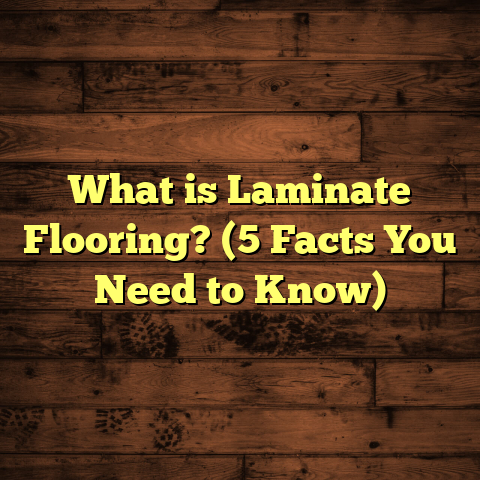What is Cork Board Flooring? (5 Benefits You Need to Know)
Did you know that cork flooring sales have increased by over 25% in the last five years among homeowners seeking eco-friendly alternatives? When I first began working in flooring, cork was something I rarely encountered. But after installing it on various projects, I quickly realized how special this material is. Let’s explore what cork board flooring really is and uncover five benefits that might surprise you.
What Is Cork Board Flooring?
Cork board flooring is made from the bark of the cork oak tree (Quercus suber), which grows mainly in Mediterranean countries like Portugal, Spain, and parts of North Africa. The cork bark is carefully harvested every 9 to 12 years without harming the tree itself—making it one of the most renewable natural resources on Earth.
The harvested cork bark is then processed into thin sheets or tiles. These sheets are compressed to form solid floor planks or tiles that can be installed in homes and commercial spaces. Unlike wood, which comes from the tree trunk, cork comes from the outer bark, which regenerates naturally.
One thing I find fascinating about cork is its cellular structure. Imagine millions of tiny air-filled cells packed together like a honeycomb. This gives cork incredible properties: it’s lightweight, compressible, elastic, and a natural insulator for both temperature and sound. These cells also make cork resistant to cracking and breaking under pressure.
Cork flooring is available in different forms:
- Glue-down tiles or sheets: These are adhered directly to a prepared subfloor using strong adhesives.
- Floating planks: These snap together with click-lock edges and float over an underlayment.
- Rolled cork floors: Used less frequently but good for large continuous areas.
The surface of cork floors is usually coated with polyurethane or other sealants to protect it from moisture, stains, and wear. This finishing layer can be matte, satin, or glossy depending on your preference.
Why Did I Start Using Cork?
When I began my career, hardwood and laminate dominated the market. Cork seemed too niche and unfamiliar. But after installing it for a client who wanted something soft and sustainable for their kids’ playroom, I discovered many advantages that other floors don’t offer. Over time, I’ve grown to appreciate cork’s blend of comfort, aesthetics, and environmental benefits.
1. Comfort and Cushioning Underfoot
If you spend hours standing on your feet—cooking, working at a desk, or playing with kids—you know how hard floors can cause fatigue. Cork flooring absorbs impact thanks to its honeycomb-like structure filled with air pockets. This natural cushioning effect is unlike hardwood or tile, which are hard and unforgiving.
I remember one project where a client switched from traditional tile kitchen floor to cork planks. After a few weeks, she told me her feet no longer hurt at the end of the day. That’s because cork reduces pressure on joints by absorbing shock with each step.
Medical studies support what I’ve seen anecdotally. A 2018 study published in the Journal of Ergonomics found that standing on softer surfaces like cork can reduce muscle fatigue and improve comfort during prolonged standing compared to hard surfaces like concrete or tile.
This cushioning doesn’t just benefit adults either. Parents often tell me how much safer they feel with cork floors because kids falling on them don’t get hurt as badly as on hardwood or stone floors.
How Does Cork Compare To Other Floors?
Compared to hardwood:
- Hardwood has minimal flexibility and transfers impact directly to your feet and legs.
- Cork compresses slightly with each step but springs back without damage.
Compared to carpet:
- Carpet offers softness but traps dust and allergens.
- Cork is firm yet cushioned and easier to clean.
I often recommend cork for kitchens, playrooms, home offices, or anywhere you stand a lot but want more comfort than hardwood can provide.
2. Thermal Insulation Keeps Your Feet Warm
Cork’s cellular makeup doesn’t just absorb impact—it also acts as a natural thermal insulator. Each cell traps air, reducing heat transfer between your floor and the ground beneath it.
This means your home stays warmer in winter and cooler in summer without extra energy usage. According to the International Cork Association, cork flooring can reduce heating costs by up to 15% because it limits heat loss through floors.
I installed cork in my own home’s basement where cold floors used to be unbearable in winter. Ever since, my feet stay warm even during chilly mornings without cranking up the heat excessively.
In contrast:
- Hardwood and tile floors tend to feel cold unless paired with radiant heating.
- Vinyl offers some insulation but doesn’t breathe well.
- Carpet insulates but is harder to clean.
If you want to improve your home’s energy efficiency while enjoying warmth underfoot year-round, cork is a smart choice.
3. Sound Absorption Creates Quieter Spaces
Ever notice how footsteps echo loudly on hardwood or tile? Cork’s structure naturally absorbs sound vibrations instead of reflecting them.
This sound-dampening quality makes a big difference in multi-story homes or apartments where noise travels easily between floors. It also reduces noise within large open spaces where echoes can be annoying.
At a recent condo project downtown, my client chose cork flooring specifically to reduce footstep noise from their neighbors upstairs. After installation, they reported a noticeable drop in noise levels and much greater privacy.
Some data points:
- Cork reduces sound transmission by up to 50% compared to traditional wood floors.
- It can reduce ambient noise levels by up to 10 decibels.
- This makes it popular for offices, hotels, daycare centers, and music rooms.
If you value peace and quiet or live in a noisy building, cork flooring can be a game-changer for indoor comfort.
4. Eco-Friendly Choice That Supports Sustainability
I’ve always cared about using materials that don’t harm the planet. Cork fits perfectly here because it’s harvested without cutting down trees—only the bark is stripped away carefully by hand every decade or so.
The bark regrows naturally which means cork oaks live for around 200 years producing bark many times over their lifespan. This cyclical harvesting process stores carbon dioxide effectively, helping reduce greenhouse gases.
The manufacturing process for cork flooring also uses less energy than producing hardwood or synthetic flooring types like vinyl or laminate. Plus, waste generated during production is minimal since offcuts can be reused or recycled easily.
Here are some key facts:
- Portugal produces about 50% of the world’s cork supply.
- Cork oak forests support unique ecosystems rich in biodiversity.
- Cork flooring carries certifications such as FSC (Forest Stewardship Council) confirming responsible harvesting.
- Because it’s biodegradable at end-of-life, cork reduces landfill waste compared to plastics.
I feel proud recommending cork to clients who want stylish floors without sacrificing environmental ethics.
5. Hypoallergenic and Low Maintenance
People with allergies often struggle with carpets trapping dust mites and pet dander. Cork flooring offers a hypoallergenic alternative because its surface resists mold, mildew, and pests naturally.
Its closed cellular structure prevents dust accumulation while still allowing the floor to “breathe,” which keeps indoor air quality healthier overall.
Cleaning cork floors couldn’t be simpler: regular sweeping or vacuuming plus occasional damp mopping with mild detergent keeps them looking great without harsh chemicals or special treatments.
A client of mine with asthma told me switching from carpet to cork drastically improved her symptoms during allergy season—something she hadn’t expected but was grateful for.
Cost Breakdown and Budgeting Tips
If you’re thinking about installing cork flooring, understanding costs helps avoid surprises.
Material Costs
- Basic glue-down cork tiles start around $3 per square foot.
- Higher-end floating plank systems can be $6-$8 per square foot.
- Specialty patterns or premium finishes push prices higher.
Installation Costs
- Professional installation ranges from $2-$5 per square foot depending on complexity.
- Subfloor prep may add costs if leveling or moisture barriers are needed.
- DIY installation is possible with floating click-lock options but requires patience and proper tools.
Compared to other floors:
| Floor Type | Material Cost per Sq Ft | Installation Cost per Sq Ft | Total Approximate Cost |
|---|---|---|---|
| Cork Flooring | $3 – $8 | $2 – $5 | $5 – $13 |
| Hardwood Flooring | $5 – $10+ | $4 – $8 | $9 – $18+ |
| Laminate Flooring | $1 – $3 | $1 – $3 | $2 – $6 |
| Tile Flooring | $3 – $10+ | $5 – $10 | $8 – $20+ |
In my experience working with clients who want durability plus comfort, cork often hits the sweet spot between cost and benefits.
Installation Tips From My Experience
Installing cork isn’t complicated but there are things you’ll want to know:
Preparation Is Key
Your subfloor must be clean, flat (level within 3/16 inch over 10 feet), dry (moisture below 2%), and structurally sound. Uneven surfaces cause problems later like cracking or lifting.
Acclimation
Before installation, let the cork boards acclimate in the room for 48 to 72 hours so they adjust to humidity and temperature changes. This prevents expansion issues after installation.
Adhesives vs Floating Systems
Glue-down tiles require special adhesive designed for cork flooring. Floating click-lock planks are easier for DIYers but may not be suitable for areas prone to moisture such as bathrooms unless properly sealed.
Sealing Edges
Seal edges thoroughly especially where water exposure might occur (kitchens/bathrooms) to prevent swelling or damage over time.
Finishing
Many prefinished cork floors come sealed ready-to-install but some require
additional coats of polyurethane after installation for extra durability.
Real-Life Case Study: A Family’s Experience With Cork Flooring
Let me share a detailed story from one family I worked with recently. The Johnsons live in Northern California with two young kids and a dog. They wanted flooring that was:
- Safe for children prone to tumbles
- Warm during cool winter months
- Easy to clean after spills
- Environmentally friendly
They chose glue-down cork tiles for their kitchen and hallway (about 300 sq ft total). After six months they reported:
- Noticeably less noise when kids ran around versus previous hardwood
- Warm feet even on chilly mornings without extra rugs
- Quick cleanup after spills—no stains or water damage
- The kids loved playing on the cushioned surface without bumps or bruises
- Positive feedback from visitors impressed by the unique look
Their satisfaction reinforced how versatile cork can be—even in high traffic areas with pets and kids running around daily.
Comparing Cork Flooring With Other Popular Options
To help you decide whether cork fits your needs best, here’s a closer look at how it stacks up against common alternatives:
Hardwood Flooring
Hardwood looks timeless but can be hard on joints due to its rigidity. It’s prone to scratches and dents from pets or heavy furniture without refinishing over time. Hardwood also tends to feel cold unless paired with radiant heat.
Laminate Flooring
Laminate mimics wood aesthetically but lacks natural warmth or cushioning underfoot. It’s more resistant to scratches but less eco-friendly due to plastics involved in manufacturing.
Vinyl Flooring
Vinyl offers waterproof qualities but lacks breathability leading to trapped moisture underfoot sometimes causing mold issues if improperly installed. The feel underfoot is artificial compared to natural cork or wood.
Carpet
Carpets provide softness but trap allergens and require frequent cleaning. They stain easily and wear out faster than hard surfaces like cork when exposed to pets or heavy foot traffic.
Common Questions About Cork Flooring
Can Cork Flooring Be Used In Bathrooms?
While cork has natural water resistance due to suberin (a waxy substance), excessive moisture can cause damage if not sealed well. Proper sealing and maintenance are essential if you want cork in wet areas like bathrooms.
How Long Does Cork Flooring Last?
With proper care and sealing, cork floors typically last 20–30 years or more before needing refinishing or replacement. Some older installations have lasted even longer in moderate traffic areas.
Is Cork Flooring Scratch Resistant?
Cork’s cellular structure makes it fairly resilient against minor scratches from pets or furniture but not impervious. Using furniture pads and trimming pet nails help maintain surface integrity longer.
How Do I Clean Cork Floors?
Use dry dust mops or vacuum regularly plus damp mop occasionally with pH-neutral cleaners designed for wood or cork surfaces. Avoid soaking floors with water during cleaning sessions.
Advanced Insights About Cork Flooring
Here are some deeper technical insights based on materials science studies I’ve read over the years:
- Density Variations: Cork density varies between 120–200 kg/m³ depending on source and processing method affecting cushioning properties.
- Compression Behavior: Cork can compress up to 40% under heavy loads without permanent deformation but regains shape quickly afterward.
- Thermal Conductivity: Cork’s thermal conductivity ranges from 0.03–0.05 W/mK, making it one of the best natural insulators among building materials.
- VOC Emissions: High-quality finished cork floors emit very low volatile organic compounds (VOCs), contributing positively toward indoor air quality certifications like LEED.
These nuances matter when choosing specific products based on your climate, usage intensity, or environmental goals.
How To Choose The Right Cork Flooring For Your Project
Not all cork floors are created equal—here’s what I recommend checking before buying:
- Thickness: Thicker planks (around 6–12 mm) offer more cushioning; thinner sheets are better suited for low traffic areas.
- Finish Quality: Opt for multiple polyurethane layers for durability; some have aluminum oxide coatings for extra scratch resistance.
- Installation Method: Decide between glue-down vs floating based on your subfloor condition and DIY capability.
- Warranty: Look for warranties covering wear-through or delamination; reputable brands offer 10+ years.
- Style & Color: Natural tones range from light honey shades to dark espresso; some manufacturers add stains or textures for varied looks.
If you want help narrowing choices based on your space needs feel free to ask—I’m happy to share product recommendations tailored to your budget and lifestyle!
Getting familiar with cork board flooring opens up a lot of possibilities beyond traditional options. Its combination of comfort, insulation, sound absorption, eco-friendliness, and ease of maintenance makes it stand out in my experience as a contractor and homeowner alike.
If you’ve been hesitant about trying something different in your home’s flooring, maybe now is time to give cork another look.
Got questions about specific products? Curious about installation steps? Just ask—I’m here to help make your flooring project smooth and rewarding!





